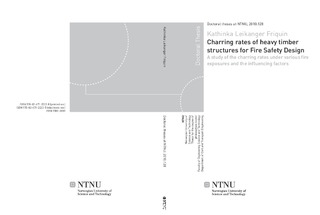| dc.contributor.author | Friquin, Kathinka Leikanger | nb_NO |
| dc.date.accessioned | 2014-12-19T11:26:50Z | |
| dc.date.available | 2014-12-19T11:26:50Z | |
| dc.date.created | 2010-10-19 | nb_NO |
| dc.date.issued | 2010 | nb_NO |
| dc.identifier | 357755 | nb_NO |
| dc.identifier.isbn | 978-82-471-2222-8 (printed ver.) | nb_NO |
| dc.identifier.isbn | 978-82-471-2223-5 (electronic ver.) | nb_NO |
| dc.identifier.uri | http://hdl.handle.net/11250/231578 | |
| dc.description.abstract | This thesis presents research on the charring rate of large structural members of timber and the material properties and external factors that influence on the charring of these members. The most commonly used temperature-time curves for large structures, and calculation models for the charring rate of wood, are evaluated and used to establish the documented charring rates.
The most important material properties and external factors that influence the charring rate of large timber structures are found by an extensive literature review, and total impact of the properties and factors are listed in tables. However, the change in charring rate due to the various properties and factors is not unambiguous and more systematic research should be carried out to determine rules. An evaluation of calculation models for the charring rate of solid wood, nail-, glue- and cross-laminated structural members was performed and the models giving results closest to test results from the literature were determined. The standard model, EN 1995-1-2, was only accurate in a few cases. The models that include more of the properties and factors found to influence the charring rate were most accurate. Evaluation of standard and parametric temperature-time curves for the design of timber structures reveal that the “Swedish” fire and iBMB fire give the best representation of a real fire in a timber structure. The EN 1991-1-2 Standard fire does not include the contribution to the fire load from the timber structure, and the EN 1991-1-2 Parametric fire has an unrealistic linear cooling stage. The experimental tests on the charring rate of cross-laminated timber panels show that the calculation models for the charring rate are inaccurate for this type of structural member. The charring rate is affected by the growth rate of the fire and the maximum temperature. High initial growth rates result in higher charring rates. Short fires with steep cooling rate will have a short charring period, while a long fire will reach constant charring rate after a while. Comparing the obtained test results with test results from other researchers gave good matches. The charring rates found during the experimental tests are compared with charring rates found using the calculation models from the literature evaluated earlier in the thesis. As the experiments only resulted in a few measurements for the “Swedish” fire and the EN 1991-1-2 Parametric fire there was not much to compare with. The char depths for the EN 1991-1-2 Standard and Parametric fires match well with each other, but the charring rates have a wide scatter.
This research has pointed out several issues where knowledge is lacking for fire safe design of large timber structures. The behaviour of exposed timber structures in compartment fires should be studied further, and the influence the timber structure has on the temperature development over time needs more research. This can result in the development of better temperature-time curves for fire exposed timber structures. The models for, calculation of the charring rate given in EN 1995-1-2 should be improved by introducing more factors and carrying out more research on the properties and factors that influence the charring rate.
| nb_NO |
| dc.language | eng | nb_NO |
| dc.publisher | Norges teknisk-naturvitenskapelige universitet, Fakultet for ingeniørvitenskap og teknologi, Institutt for bygg, anlegg og transport | nb_NO |
| dc.relation.ispartofseries | Doktoravhandlinger ved NTNU, 1503-8181; 2010:128 | nb_NO |
| dc.relation.haspart | Friquin, Kathinka L.. Material properties and external factors influencing the charring rate of solid wood and glue-laminated timber. . | nb_NO |
| dc.relation.haspart | Friquin, Kathinka L.. Evaluation of natural and parametric temperature-time curves for the fire design of cross-laminated wood slabs. Proceedings ofInternational Conference Application of Structural Fire Design: 563-568, 2009. | nb_NO |
| dc.relation.haspart | Leikanger Friquin, Kathinka. A review of models for the charring rateof solid wood, nail- and glue-laminated structural members. Journal of Structural Fire Engineering. (ISSN 2040-2317). 1(1): 61-72, 2010. <a href='http://dx.doi.org/10.1260/2040-2317.1.1.61'>10.1260/2040-2317.1.1.61</a>. | nb_NO |
| dc.relation.haspart | Friquin, Kathinka L; Grimsbu, Mads; Hovde, Per Jostein. Cross-laminated timber panels - Experimental study of the charring rates when exposed to standard and parametric fires. . | nb_NO |
| dc.relation.haspart | Friquin, Kathinka L. Experimental charring rates for cross-laminated timberpanels compared to calculated charring rates. The conference proceedings of the 12th International Conference on Fire Science and Engineering (InterFlam), 2010. | nb_NO |
| dc.title | Charring rates of heavy timber structures for Fire Safety Design: A study of the charring rates under various fire exposures andthe influencing factors | nb_NO |
| dc.type | Doctoral thesis | nb_NO |
| dc.contributor.department | Norges teknisk-naturvitenskapelige universitet, Fakultet for ingeniørvitenskap og teknologi, Institutt for bygg, anlegg og transport | nb_NO |
| dc.description.degree | PhD i bygg, anlegg og transport | nb_NO |
| dc.description.degree | PhD in Civil and Transport Engineering | en_GB |

